
|
![]()
Greatest Films of the 1940s
1940 | 1941 | 1942 | 1943 | 1944 | 1945 | 1946 | 1947 | 1948 | 1949
Title Screen Film Genre(s), Title, Year, (Country), Length, Director, Description 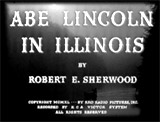


Abe Lincoln in Illinois (1940), 110 minutes, D: John Cromwell
A screen adaptation from Robert E. Sherwood's 1939 Pulitzer Prize-winning play, yet slightly inferior to the previous year's Young Mr. Lincoln (1939) starring Henry Ford. An historically accurate and realistic portrayal of Abraham Lincoln's (Raymond Massey, reprising his 1938 Broadway stage impersonation and future signature role) life as small-town resident, suitor, lawyer, legislator, and as the 16th President (and Great Emancipator) beginning in 1860. The film opened with Lincoln's poor childhood in the backwoods of Illinois, through his early career as a clerk in a shop in New Salem, Illinois, his ill-fated love for Ann Rutledge (Mary Howard) who was already engaged and then died tragically in 1835, his reluctant decision to run for political office for the first time as a Whig Party state assemblyman (and serve a single term), his short stint as a self-educated lawyer in Springfield, Illinois, his on-again, off-again relationship with ambitious Mary Todd (Ruth Gordon in her debut film role) and their eventual marriage in 1842, his election to a single two-year term in Congress (1846-48), his memorable debates (the highlight of the film) as a Republican candidate against political rival Senator Stephen Douglas (Gene Lockhart) who defeated Lincoln and won the Senate seat in 1858, and Lincoln's election to the Presidency.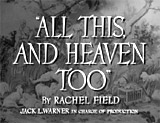



All This, And Heaven Too (1940), 140 minutes, D: Anatole Litvak
An elaborate, overly-long melodramatic,19th century period production from Warner Bros., set in France, and based upon Rachel Lyman Field's novel about a scandalous and tragic real-life murder case in Europe. A philandering French nobleman Duc de Praslin (Charles Boyer) entered into a loving relationship with the governess of his children, Henriette Deluzy-Desportes (Bette Davis). His sultry and cold wife Duchesse de Praslin (Barbara O'Neil) was insanely jealous and resentful of the kindly and loving Henriette and the affair that was occurring, although she was uncaring about her own four children. Henriette was fired from her governess position, due to the Duchesse's vindictive nature, and denied a letter of recommendation, leaving Henriette unemployed. The debonair Duke and his governess became prime suspects after the Duchesse was murdered by the enraged Duc - and Henriette was considered his accomplice. To save her and the French government (because of his associations with the French king Louis-Philippe) from further embarrassment, the Duke suicidally took poison and assumed full responsibility for the crime. Henriette was released from prison without evidence to hold her, and she emigrated for refuge to the US (where she told her story in flashback) as a French teacher in NY's Miss Haines School.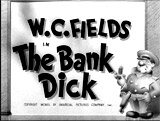

The Bank Dick (1940), 73 minutes, D: Eddie Cline
A great classic W. C. Fields comedy, with wonderful sight gags and one-liners. Fields (in his last major film role) credited himself as screenwriter Mahatma Kane Jeeves (similar to "My hat, my cane, Jeeves!"). A drunken, unemployed no-account, henpecked husband in Lompoc, California (pronounced Lompoke) - Egbert Souse (W. C. Fields) (pronounced "Soo-zay") - inadvertently foiled a bank robbery in town, and was rewarded for his accidental heroism with an in-bank position as a guard (or "dick"-detective) by grateful bank president Mr. Skinner (Pierre Watkin). Egbert's most frequent visits were to the Black Pussy Cat Cafe for stiff drinks. Egbert was conned by J. Frothingham Waterbury (Russell Hicks) to fund a flimsy mining operation, Beefsteak Mines. He convinced bank clerk Og Oggilby (Grady Sutton) - his future son-in-law, the dim-witted fiancee of his daughter Myrtle (Una Merkel), to embezzle $500. And then he had to avoid having auditing bank examiner J. Pinkerton Snoopington (Franklin Pangborn) discover his crime by slipping him a drink. Hilarious, bumbling antics ensue, concluding with another bank robbery and a classic car chase sequence, with Egbert taken as hostage.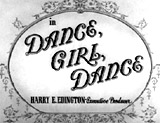


Dance, Girl, Dance (1940), 90 minutes, D: Dorothy Arzner
An early feminist-minded film, and a critical and commercial box-office failure, from pioneering butch-lesbian Dorothy Arzner (and regarded as her best) - one of the few female Hollywood directors at the time, and featuring one of Lucille Ball's better film roles. Not to be confused with the 1933 film of the same name. This backstage musical was taglined: "Heartbreak Behind Gayety of a Girly-Girl Show!" and pitted the two dichotomous female leads against each other - a good girl vs. bad girl representing two opposite styles of dance (burlesque and ballet). Aspiring 'serious' but poor ballerina Judy O'Brien (young Maureen O’Hara in her third Hollywood film), an Irish redhead, and her outrageous, gold-digging, ambitious friend Bubbles (Lucille Ball) were introduced as two chorus girls stranded in Akron, Ohio before they traveled separately back to New York City to find work. Bubbles (renamed "Tiger" Lily White) became a cheap burlesque stripper in a live show, while Judy struggled in dance school with her Russian dance teacher/mentor Madame Lydia Basilova (Maria Ouspenskaya). With a cruel and cutthroat gesture, Bubbles hired the desperate Judy to dance ballet immediately after her own act, knowledgeable that "stooge" Judy would be greeted with hostile jeers, boos, and laughter from the voyeuristic dirty-old-man audience, and would - of course - demand an encore by Bubbles (who only stripped to a hula skirt and bra!). Besides an on-stage catfight, the film's most remarkable sequence was Judy's celebrated lecture-speech delivered at the climax to the males of a jeering burlesque audience who were mocking her classical dance act.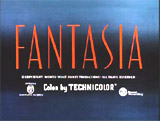


Fantasia (1940), 120 minutes, D: Ben Sharpsteen and Disney
An innovative and revolutionary animated classic from Walt Disney (his third feature animation), combining classical music masterpieces with imaginative visuals, presented with conductor Leopold Stokowski and the Philadelphia Orchestra. It was the first commercial American film to use stereophonic sound as well as the first and only film recorded in pioneering Fantasound. An updated version was created almost 60 years later, Fantasia/2000 (1999) - the first feature length animated film to be presented in IMAX, with additional animated interpretations of classical works, including Beethoven's "Symphony No. 5," Gershwin's "Rhapsody in Blue," Saint-Saëns' "Carnival of Animals," and Stravinsky's "The Firebird Suite." The eight animation sequences in this film, corresponding to classical music selections, were colorful, impressive, free-flowing, abstract, and often surrealistic pieces. They included the most famous of all: Paul Dukas' "The Sorcerer's Apprentice" with Mickey Mouse (in a comeback role) as the title character - the wizard's disobedient assistant battling brooms carrying endless buckets of water. Also Bach's "Toccata and Fugue in D Minor," Tchaikovsky's "Nutcracker Suite" with sugar plum fairies and dancing mushrooms, prehistoric dinosaurs and volcanoes in Stravinsky's "Rite of Spring," Beethoven's "Pastoral Symphony" with mythical Greek centaurs, cupids, and fauns, Ponchielli's delightful "Dance of the Hours" with dancing hippo ballerinas, crocodiles, ostriches, and elephants, and Mussorgsky's darkly apocalyptic "Night on Bald Mountain" with evil creatures.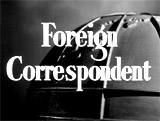



Foreign Correspondent (1940), 120 minutes, D: Alfred Hitchcock
A thrilling and suspenseful espionage masterpiece from Alfred Hitchcock, his second American film. A naive American police reporter, Johnny Jones/Huntley Haverstock (Joel McCrea), the foreign correspondent of the title (loosely based upon real-life reporter Ed Murrow), was sent to Europe in 1939 just prior to the outbreak of war in Europe, to cover the unfolding story. He met peace activist Stephen Fisher (Herbert Marshall), fell for his attractive daughter Carol (Laraine Day), accidentally became involved chasing spies, and began to suspect that Fisher was part of a Nazi spy ring (masquerading as an international peace organization). Memorable scenes included the faked Amsterdam assassination scene of Dutch diplomat Van Meer (Albert Bassermann) in a crowded sea of umbrellas, the mysterious Dutch windmills (Nazi hideouts), a murder attempt in Westminster Cathedral Tower, and a spectacular trans-Atlantic ocean plane crash. The film concluded with a memorable radio speech/plea for neutrality-leaning America to join the war effort.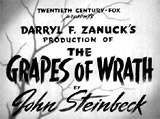


The Grapes of Wrath (1940), 128 minutes, D: John Ford
A powerful, classic socio-dramatic masterpiece, adapted from John Steinbeck's 1939 Pulitzer Prize-winning novel, reputedly with Henry Fonda's greatest film role. It was the epic, but heartbreaking story of the perilous, Depression-Era migration of a drought-stricken, Oklahoma Dust Bowl family to the promised land of California, seeking migrant farm work during the fruit harvest. Cinematography by Gregg Toland duplicated images immortalized by documentary photographer Dorothea Lange. When they reached California, they were met with violence, prejudice, and fear, moving from one squalid campsite to the next, and being mistreated as migrant laborers. With magnificent performances of the family members who were poor but honest people struggling for dignity and a better way of life, especially the idealistic son Tom Joad (Henry Fonda) and his loving matriarchal Ma Joad (Jane Darwell) (with her famed "We're the people" monologue).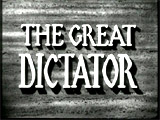

The Great Dictator (1940), 127 minutes, D: Charles Chaplin
Charles Chaplin's first full talking feature film in which he delivered spoken lines - a full 13 years after the advent of sound in the movies. The film was a slapstick political satire on world conditions and fascism at the start of World War II, and it was soon detested by Hitler's Third Reich. Chaplin played a dual role: as a poor and kind, unnamed Jewish ghetto barber with amnesia, and as a Hitler look-alike, the ruthless tyrannical dictator Adenoid Hynkel of the European country of Tomainia - a persecutor of Jews. The criss-crossing stories of the barber and the dictator eventually ended in a case of role reversal and mistaken identities. The barber won the admiration of pretty neighbor girl Hannah (Chaplin's wife at the time Paulette Goddard). Hynkel's rival was Mussolini-like Benzino Napaloni (Jack Oakie) of the neighboring country of Bacteria. With the funny pudding-coin scene, the memorable scene of Hynkel dancing ("pas de deux") with an inflated world globe balloon to the tune of the Overture of Richard Wagner's Lohengrin, and the competition between Hynkel and Napaloni in adjoining, ascending barber chairs, followed by a comedic food fight. The film concluded with a lengthy and impassioned humanistic monologue by the barber (appearing like Hynkel) about hope and human rights, and the end of tyranny.


The Great McGinty (1940), 81 minutes, D: Preston Sturges
The classic film (aka The Biography of a Bumb) that debuted the talents of screwball comedy director and screenwriter Preston Sturges (with an Oscar-winning original script). A witty, satirical, and cynical look at corrupt American politics and society, told with a stock cast of comical characters. In flashback, a banana republic bartender, Dan McGinty (Brian Donlevy) told the story of his rise from obscurity to the state governor's mansion as the result of a crooked election and lots of dirty tricks. Starting out as a dumb and homeless hobo in Chicago, he was admired by the Boss (Akim Tamiroff), head of the political machine, for his feisty nature and for stuffing the ballot box with phony votes. By playing the game crookedly, he was appointed collector of protection money, alderman, and through charm and more appointments, became mayor and eventually governor (the Great McGinty). Along the way, when he cleaned up his act and became honest - there were reverse consequences. He married his divorcee secretary Catherine (Muriel Angelus) - and then fell in love with her and her ready-made family of two children, developed a social conscience, and lost it all. He suffered a political demise when he tried to go straight, fight corruption and promote real reform as governor - opposed by the Boss - and had to flee the country. [Note: Brian Donlevy and Akim Tamiroff reprised their roles as Governor McGinty and The Boss in Preston Sturges' The Miracle of Morgan's Creek (1944).]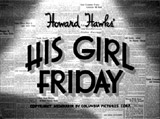

His Girl Friday (1940), 91 minutes, D: Howard Hawks
One of the earliest and best of Howard Hawks' madcap comedies with fast pacing, whirlwind, rapid-fire dialogue, and sped-up action. Remade as director Billy Wilder's The Front Page (1974) with Jack Lemmon and Walter Matthau, and as director Ted Kotcheff's Switching Channels (1988) within a television news environment. A funny and witty remake of the 1929 Ben Hecht and Charles MacArthur stage play hit The Front Page (and the subsequent The Front Page (1931)), but switching gender roles so that the reporter was played by a woman. Newspaper reporter Hildy Johnson (Rosalind Russell) wanted to leave the paper, find a more domestic and less frantic life style, and marry a mild-mannered, stuffy mama's boy insurance agent Bruce Baldwin (Ralph Bellamy). But her suave, scheming newspaper editor Walter Burns (Cary Grant), her ex-husband, wanted to keep his star reporter. When a hot-breaking escaped convict/manhunt story developed and she was called upon to cover the story and write the front-page headline scoop, he attempted to win her back in a battle of the sexes.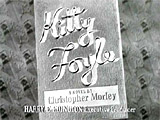


Kitty Foyle (1940), 105 minutes, D: Sam Wood
RKO's acclaimed romantic melodrama (a classic "chick flick"), subtitled "The Natural History of a Woman," featured dancer Ginger Rogers in her first serious acting role in one of the best "women's pictures" of the 40s. A touching and poignant love story/soap opera, told mostly in flashback. Adapted from a screenplay, based on Christopher Morley's popular novel (which contained more racy material, including explicit sexuality and an abortion). An ambitious, attractive white-collar working girl-secretary, Kitty Foyle (Best Actress-winning Ginger Rogers) found herself in a love triangle with a noble, but poor, idealistic and struggling doctor Mark Eisen (James Craig), and her wealthy, still-married philandering ex-husband, rich Philadelphia socialite Wynnewood 'Wyn' Strafford VI (Dennis Morgan) whom she was strangely drawn to. Her reflections on her choice of beaux (wealth vs. poverty) were told through flashback. The film also used a technique of a 'mirror-image' conscience to show two sides of Kitty's personality (the rational vs. the emotional and impulsive) during her dilemma. Caught in a difficult love triangle, she had to choose in the final scene: (1) should she go with Wyn who was on the dock ready to sail for South America?, or (2) should she join Mark at the hospital? She decided to marry Mark after she said to herself: "You're no longer a little girl, you're a grown woman now." She left a note with the doorman regarding her choice of life's path: ("...I'm going to be married tonight -- (to taxi driver: "St. Timothy's Hospital")).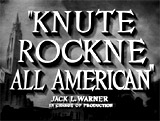


Knute Rockne All American (1940), 96 minutes, D: Lloyd Bacon
A sentimental, inspirational sports biography-drama of Notre Dame's legendary and dedicated football coach, who became known for rousing pep talks to his players, exhorting them to greatness. One of the best sports movies of all-time. The film began with Knute Rockne's (Pat O'Brien) boyhood, his schooling and football days at Notre Dame, graduation, marriage to Bonnie Skiles (Gale Page), and the start of his coaching career for the Fighting Irish. The film contained actual newsreel footage of Notre Dame football games, and was most-remembered for Rockne's stirring words to his team during half-time in a game against Army to "go out there with all they got and win just one for the Gipper" - to play in memory of superb ND grid-iron half-back player George Gipp (Ronald Reagan) who died at the early age of 25 from a "disease" - pneumonia (and complications from strep throat). The film concluded with the tragic plane crash in 1931 that took 43 year-old Rockne's life, and his funeral with a eulogy by university president, Father Callahan (Donald Crisp).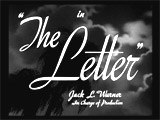




The Letter (1940), 95 minutes, D: William Wyler
A superb melodrama from Warner Bros., adapted from the W. Somerset Maugham play. The story was filmed once before as the silent The Letter (1929) with Jeanne Eagels, and remade as The Unfaithful (1947), starring Ann Sheridan. Director Wyler was again paired with Bette Davis, after their success with Jezebel (1938). On the grounds of a Malayan rubber plantation one evening, bored and restless wife Leslie Crosbie (Bette Davis) shot and point-blank killed old family friend Geoffrey Hammond (David Newell) on the porch and front steps of her home with her husband's gun - in the striking opening scene. She explained to her husband Robert (Herbert Marshall) (who was away on business at the time of the murder) and their hired respected lawyer Howard Joyce (James Stephenson), with cold calculation and manipulation, that it was self-defense to protect her honor. Her husband faithfully believed her. She claimed that Hammond, who was married to an Eurasian - Mrs. Hammond (Gale Sondergaard), had tried to rape her. She was to stand trial in Singapore for murder. [Note: In fact, she killed him because as her lover, he threatened to leave her to take another partner.] During the proceedings, clerk Ong Chi Seng (Victor Sen Yung) presented Joyce with a copy of an incriminating letter written from Leslie to Geoffrey on the day of the shooting, desperately asking to see him. The letter was in the possession of Hammond's widow, who blackmailed them by offering to sell it for $10,000 (Robert's savings). Leslie tearfully admitted her affair with Hammond. The letter had to be retrieved personally in a dramatic scene. During the subsequent court trial, Leslie was found innocent of murder charges, because the incriminating evidence wasn't produced. Stephenson told the jury it was "a simple, uncomplicated case" - after she again claimed she shot Hammond in self-defense. However, on the night of the acquittal, Leslie suffered a fateful retribution in the conclusion, when she was knifed in the dark by Mrs. Hammond. According to the Hays Code, she had to pay and be punished for her indiscretion.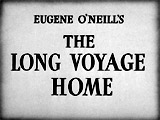

The Long Voyage Home (1940), 105 minutes, D: John Ford
Adapted from four short, one-act plays by Eugene O'Neill that were condensed into one screenplay. This was Ford's first war film - and first WWII film (he later directed They Were Expendable (1945)). Set in pre-World War II year of 1939. In a series of vignettes, the gripping film took a look at the lives and loves, hopes, dreams, and comradeship of working-class Merchant Marine seamen. Their British freighter, the S.S. Glencairn, was transporting dynamite in a dangerous mission-convoy from America to England, and was threatened by bad weather at sea, German U-boats and strafing plane attacks, the death of beloved crew member Yank (Ward Bond), and suspicions of treason against Smitty (Ian Hunter), one of the sailors. With effective performances by John Wayne as young Swedish sailor and farm-boy Ole Olsen returning home to his mother's farm-home, and Thomas Mitchell as fellow seamate Aloysius Driscoll. Included atmospheric, high-contrast, black and white cinematography by the famous Gregg Toland. An epilogue ended the film: "So men like Ole come and go, and the Driscolls live and die, and the Yanks and Smittys leave their memories - but for the others the Long Voyage never ends."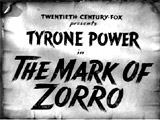

The Mark of Zorro (1940), 93 minutes, D: Rouben Mamoulian
A swashbuckling adventure story from 20th Century Fox, a remake of the 1920 silent classic with Douglas Fairbanks, Sr. - capitalizing on the adventure tale craze following the success of The Adventures of Robin Hood (1938). Also the Zorro tale was made into Republic Pictures serials (for example, Zorro Rides Again (1937) and Zorro's Fighting Legion (1939)), a late 1950s TV series (by Walt Disney) starring Guy Williams, and later The Mask of Zorro (1998) with Antonio Banderas. Cavalry officer Diego de Vega (Tyrone Power), the son of an early 19th century California aristocrat Don Alejandro Vega (Montagu Love), returned home after an education in Spain. He found power had been usurped from his father by corrupt oppressors led by Don Luis Quintero (J. Edward Bromberg) and his tax-collecting henchman led by Capt. Esteban Pasquale (Basil Rathbone). Pasquale was also having an affair with Quintero's greedy wife Inez (Gale Sondergaard). By day, nobleman-aristocrat Diego was considered a carefree and harmless fop, but at night he donned a black outfit, a mask and a sword, and rode to avenge the tyrants, carving the letter Z signifying his name: Zorro. The film included some of the best dueling scenes in cinematic history, between Zorro and Capt. Pasquale. In the end, the cruel regime was overthrown, and Zorro's father was reinstated as governor or Alcalde (leader of the community). Zorro's love interest was provided by Quintero's pretty daughter Lolita (Linda Darnell).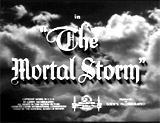

The Mortal Storm (1940), 100 minutes, D: Frank Borzage
A propagandistic MGM melodrama that was a flop at the box-office. It was based upon Phyllis Bottome's best-selling, pre-war 1938 novel, about ideological differences dividing up a family. The strong anti-fascist and anti-Semite message of the anti-Nazi film (one of the first Hollywood films of its kind, released a few months before Chaplin’s The Great Dictator) caused it to be banned by the Aryan supremacist Nazis in Germany, led by Hitler's propaganda minister Joseph Goebbels. It told about the Roth family living idyllically and peacefully in the early 1930s in a small fictional Alpine village in Southern Germany - and the repercussions after Adolf Hitler came to power as Chancellor in the Third Reich in 1933 and Nazism slowly pervaded the country. The family was led by outspoken, respected, "non-Aryan" (or Jewish) 60 year-old teacher of biology Viktor Roth (Frank Morgan) at a Bavarian educational institution. Pretty daughter Freya Roth (Margaret Sullavan) was courted by young fascist Fritz Marberg (Robert Young), one of her father's students, but then rejected him in favor of more sensitive rival Martin Brietner (James Stewart), a long-time family friend, and Roth's protege as a pacifist veterinary student. Two Roth stepsons, Otto (Robert Stack) and Erich (William T. Orr), both supported the rise of Hitler and the Hitler Youth Organization, causing more friction and a rift in the family. When Professor Roth opposed the Nazi doctrines about racial segregation and a master race of Aryans, he was removed from his position, arrested and sent to a hard labor concentration camp, where he died under mysterious circumstances. In the grim conclusion, Martin aided Freya in an attempt to escape from Germany by crossing the border into Austria - by skiing through a mountainous snowy pass, where they were spotted by a Nazi platoon patrol led by Fritz. Although they were able to cross the border successfully, Freya was mortally wounded and died in Martin's arms.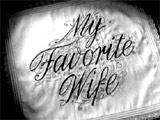


My Favorite Wife (1940), 88 minutes, D: Garson Kanin
One of the classic marital screwball comedies of all time - an attempt to repeat the success of director Leo McCarey's The Awful Truth (1937) (featuring the same two stars and producer McCarey). It was the second of three films which paired Cary Grant and Irene Dunne, followed by Penny Serenade (1941). It was to be remade as Something’s Gotta Give (1962) with Marilyn Monroe (who died before completion), and officially remade as Move Over, Darling (1963) with Doris Day and James Garner. Taglined: "The funniest, fastest honeymoon ever screened!" with all the characteristics of screwball comedy - fast paced dialogue, absurd and wacky circumstances, and some slapstick. Ellen Arden (Irene Dunne), the wife of a young attorney was shipwrecked on a South Seas voyage during a typhoon and presumed lost. In reality, she was alive, marooned on a desert island with another survivor, a handsome young scientist Stephen Burkett (Randolph Scott). Declared legally dead after seven years, she happened to arrive back on the day of her husband Nick Arden's (Cary Grant) remarriage to Bianca (Gail Patrick) and their honeymoon night. He was stunned by her reappearance - what was he to do, and what about the other man who may have compromised her?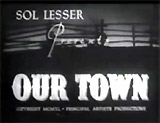


Our Town (1940), 90 minutes, D: Sam Wood
An innovative film presentation of Thornton Wilder's 1938 Pulitzer Prize-winning play, a much-loved classic, dramatic story of human life, love, tragedy and conflict, set in the simple, small New England town of Grover's Corners, New Hampshire. The story was told in three sequences depicting the years before WWI (1901, 1904, and 1913). With a great musical score by composer Aaron Copland, and production design by William Cameron Menzies. In contrast to the play that was performed without scenery and only a few props, the film included realistic scenery. The film was given down-home commentary by the omniscient Narrator or Stage Manager, drugstore owner Mr. Morgan (Frank Craven), who profiled the lives of the town's residents. It centered around young teenaged Emily Webb (Martha Scott), the hard-working daughter of the town's newspaper editor Mr. Webb (Guy Kibbee), who fell in love with high-school student George Gibbs (William Holden), son of the local doctor, Dr. Gibbs (Thomas Mitchell). They courted each other over a period of time and eventually married , but she was lost during childbirth for her second child. In a ghostly afterlife existence, Emily was given special permission to go back and re-live just one day of her life - the day of her 16th birthday (her 12th birthday in the play), and learned how little the quiet, everyday, fleeting moments of life were precious - and under-appreciated. In the twist ending epilogue (a severe modification from the play's original downbeat ending), Emily woke up from the temporary coma resulting from childbirth - and realized the film's third episode was just a dream.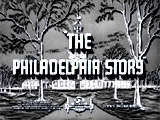

The Philadelphia Story (1940), 112 minutes, D: George Cukor
A classic romantic comedy, a witty adaptation of Phillip Barry's Broadway hit. Hepburn financed the play (with financial help from Howard Hughes) that she starred in (with Joseph Cotten and Van Heflin) in 1939-1940, then picked the director, screenwriter, and other co-stars for the movie. Remade as a musical, High Society (1956) with Grace Kelly, Frank Sinatra and Bing Crosby. Set among the upper class society in Philadelphia, a spoiled, wealthy heiress, Tracy Lord (Katharine Hepburn) was about to be married to a stuffy executive, millionaire George Kittredge (John Howard). She divorced her dashing first husband C. K. Dexter Haven (Cary Grant) because he drank excessively and was irresponsible. He still loved her and showed up in attendance. So did Spy Magazine's tabloid reporter Macauley "Mike" Connor (Best Actor-winning James Stewart) and a photographer. Dexter was there to prevent them from publishing a scandalous expose about the womanizing reputation of Tracy's father Seth (John Halliday), his ex-in-law. Things got complicated when the inquisitive, cynical Connor fell in love with Tracy and taught her what love was.


Pinocchio (1940), 87 minutes, D: Ben Sharpsteen and Hamilton Luske and Disney
Walt Disney's second full-length animated feature film, a brilliant classic based on the story by Collodi, was a masterful, animated achievement. Released the same year as Disney's Fantasia (1940). The tale was told by a chirpy cricket named Jiminy Cricket (voice of Cliff Edwards), who served as the narrator and guiding conscience of the story. The plot was about a lonely, poor, toy shop woodcutter Geppetto (voice of Christian Rub) who created an inquisitive marionette wooden boy named Pinocchio (voice of Dick Jones). His wish that Pinocchio would become a real boy (earlier, Jiminy had sung Oscar-winning Best Song "When You Wish Upon a Star") was made true by a blue fairy, although the boy was still made of wood. If he proved himself to be brave and unselfish (challenged by life's coming-of-age dangers), he would be changed into a real flesh-and-blood boy. Pinocchio quickly ran afoul by associating with bad company, including the unforgettable characters of two devious crooks (J. Worthington Foulfellow (a fox) and a cat), the evil stage showman/puppet master Stromboli, and influential juvenile delinquent Lampwick on Pleasure Island where temptations were everywhere. With some truly frightening sequences, including Lampwick's transformation into a donkey, and scary Monstro the whale.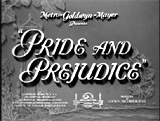


Pride and Prejudice (1940), 117 minutes, D: Robert Z. Leonard
Adapted from Jane Austen's novel, with a screenplay partially written by author Aldous Huxley. This MGM film was a dramatic, witty comedy of manners and morals. Remade many times, especially Joe Wright's Pride & Prejudice (2005) with Keira Knightley and Matthew Macfadyen. Early 19th century English (pre-Victorian) parents, the Bennets (Edmund Gwenn and Mary Boland) were looking to marry off their five eligible daughters - opinionated Elizabeth (Greer Garson), lovely and gentle Jane (Maureen O'Sullivan), Lydia (Ann Rutherford), Kitty (Heather Angel), and Mary (Marsha Hunt). Fortunes looked favorable when some eligible young men stayed at a neighboring country house. Each girl had her own peculiarities - flirtatious, silly, serious, bookish, plain, lovely, and gentle. A difficult, contrary romance developed between arrogant but handsome Mr. Darcy (Laurence Olivier) and the overly spirited, and independent Miss Elizabeth. At first, she rejected him for his prideful nature, then changed her mind and admitted her own pride hindered their relationship.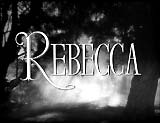



Rebecca (1940), 130 minutes, D: Alfred Hitchcock
Adapted from British writer Daphne du Maurier's 1938 novel of gothic romance and mystery, a compelling and intriguing romance-mystery with intense psychological suspense. This was Alfred Hitchcock's debut American film - a winning Best Picture. Following a rapid courtship, a shy, naive young woman became the second Mrs. de Winter (Joan Fontaine) by marrying a dashing, but brooding British nobleman 'Maxim' de Winter (Laurence Olivier). The new wife was taken to live at his huge Manderley mansion-estate, where she was haunted by the memory and shadow of her husband's beautiful first wife, Rebecca, who died under mysterious circumstances. The icy-cold, creepy housekeeper Mrs. Danvers (Judith Anderson) taunted and frightened her, as did the other servants, while she heard about how adored the dead woman remained. The untold secrets of the past were slowly unraveled, when the remnants of Rebecca's intentionally-sunken boat wash ashore, and Mr. de Winter confessed that Rebecca tormented him. The ending revealed important findings: (1) Rebecca was not pregnant with another man's child, but terminally ill with cancer, (2) Rebecca intended to goad Maxim into killing her, (3) When Maxim wouldn't kill her as she wished, she planned to commit suicide, but fell and hit her head on some boat tackle in the beach house. (4) Maxim covered up her accidental death by putting her in a boat and deliberately sinking it. The second Mrs. de Winter was finally free from her fear and uneasiness when Mrs. Danvers suicidally burned down the estate - and consumed (literally) the haunting memories of the past.


Santa Fe Trail (1940), 110 minutes, D: Michael Curtiz
An action-filled, but historically-inaccurate adventure tale from WB Studios, a misnamed Western. This was the seventh of nine movies co-starring the romantic coupling of Olivia de Havilland and Errol Flynn. The film followed the military life of the future great Confederate general, Virginian Jeb Stuart (Errol Flynn). He began his military career as a West Point student, where he had a strong friendship with George Armstrong Custer (Ronald Reagan) (completely inaccurate historically), and other future military leaders. There, a rival cadet Rader (Van Heflin), who supported fanatical abolitionist activities, was dismissed for agitation - their paths would cross again later. Cavalry officer Jeb was assigned to a Kansas post (Ft. Leavenworth) with other Point graduates, to keep the peace (due to a war over whether Kansas would be slave or free) and quell any uprisings. On the train to Kansas, Stuart met and began a romance with 'Kit Carson' Holliday (Olivia de Havilland), whom he would eventually marry. The film ended with Stuart capturing fanatical abolitionist John Brown (Raymond Massey) at Harper's Ferry arsenal at the Maryland-Virginia border, leading to lunatic agitator's hanging.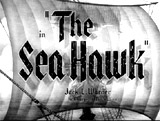


The Sea Hawk (1940), 109 minutes, D: Michael Curtiz
An exciting and spirited swashbuckler (with great swordplay and sea battles), one of the best of its kind, adapted from the 1915 novel by Rafael Sabatini. [Note: Sabatini was also the author of the 1921 novel Scaramouche which was made into an MGM film in 1952 with Stewart Granger).] With a tremendous score by Erich Wolfgang Korngold. This film reprisal solidified the image of star Errol Flynn as a dashing action character (after his appearance in Michael Curtiz' earlier film Captain Blood (1935), also from another Sabatini novel written in 1922). Set in the 16th century, Queen Elizabeth I of England (Flora Robson) suspected that Spanish King Phillip II (Montagu Love) and his crafty ambassador Don José Alvarez de Cordoba (Claude Rains) were planning to spread their influence over the continent. The Spaniards were getting ready to launch a naval attack with their armada against England. The Queen secretly commissioned swashbuckling privateer, British sea captain Geoffrey Thorpe (Errol Flynn), "the Sea Hawk," to raid Spanish settlements and ships. While threatening the Spanish, the beautiful daughter of the ambassador Doña Maria (Brenda Marshall) fell in love with buccaneer pirate Thorpe. He and his crew were ambushed and imprisoned by Spanish forces. With Maria's aid, he escaped slavery aboard a Spanish galleon slave ship, and helped alert the Queen to the impending Armada attack.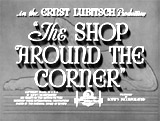


The Shop Around the Corner (1940), 97 minutes, D: Ernst Lubitsch
A brilliant and charming romantic comedy about everyday people in a "shop around the corner," with all the right elements (deception and mistaken identities in a love-hate relationship) to create the right "Lubitsch touch." Remade as a musical, In the Good Old Summertime (1949) with Judy Garland and Van Johnson, as the 1963 Broadway play She Loves Me that was also a BBC-TV movie in 1978, as well as the updated You've Got Mail (1998) with Tom Hanks and Meg Ryan. A Budapest notions/gift shop head sales clerk, bookish bachelor Alfred Kralik (James Stewart) and newly-hired shopgirl Klara Novak (Margaret Sullavan) mutually disliked each other and bickered constantly. They were unaware that they were each other's anonymous pen pals writing each other very literate correspondence. On paper, they were romantically compatible, and corresponded with affectionate "lonely-hearts" letters. On the same night that the two pen pals agreed to meet, Alfred was fired by his employer Hugo Matuschek (Frank Morgan), wrongly suspected of having an affair with his wife. Alfred sought solace with his pen-pal sweetheart in a cafe, in a memorable sequence, but didn't reveal his identity to her as pen-pal until later, stringing her along. In the end, Alfred was rehired, and he finally revealed his identity to Klara.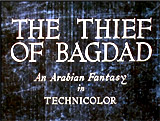




The Thief of Bagdad (1940, UK), 106 minutes, D: Ludwig Berger, Michael Powell and Tim Whelan, produced by Alexander Korda
Subtitled: An Arabian Fantasy. A remake of the magical 1924 silent film, and remade as The Thief of Bagdad (1961, It.) with Steve Reeves. Disney’s animated Aladdin (1992) heavily borrowed from this version. One of the best, most enchanting fantasies ever made - with an Arabian Nights theme, including spectacular special effects (a mechanical horse, a huge spider, an All-Seeing Eye (ruby jewel), the 6-armed Silver Maid statue, etc.), amazing Technicolor photography, a memorable musical score, and wonderful performances. The film's story began, in flashback, told by an elderly and deposed blind King Ahmad (John Justin) of the city of Bagdad, now a beggar. He explained how he was tricked out of his kingdom by an oppressive, evil magician-sorcerer named Jaffar (Conrad Veidt), his treacherous Grand Vizier. A mischievous young urchin named Abu (Sabu), who was thrown in a dungeon for theft, helped the good-hearted, prince Ahmad escape. In the city of Basra, he fell in love (at first sight) with the sultan's daughter, the Princess (June Duprez). Unfortunately, the two were captured - Ahmad was blinded, while Abu was magically turned into Ahmad's seeing-eye dog by a black magician. The two were promised they would be restored if they rescued the Princess. In the end, they save Ahmad's kingdom and throne and his love. Abu and Ahmad were helped by a giant yet jovial genie Djinni (Rex Ingram) who emerged in black smoke from a bottle, and a magical flying carpet.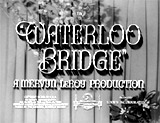


Waterloo Bridge (1940), 109 minutes, D: Mervyn LeRoy
A classic, sentimental, romantic tearjerker, Vivien Leigh's first film following her success in Gone With The Wind (1939). Middle-aged British colonel Roy Cronin (Robert Taylor) paced on the famous Waterloo Bridge in the city of London during World War II, and in flashback, remembered when he was a handsome Army Captain ready to depart for the trenches in World War I. He fell in love with naive young ballerina Myra Lester (Vivien Leigh), but was called off to war and their plans to wed were postponed. Bidding him farewell at the Waterloo train station, she abandoned her dance performance and was fired from the ballet company. Desperate, Myra soon descended into poverty, became destitute, and turned to prostitution, walking the Waterloo Bridge for clients. She falsely learned that Roy had been killed in the war, but in a memorable scene, accidentally mt him when he returned, while she was soliciting business from returning soldiers. During their reunion, Myra didn't reveal her occupation to him. They renewed their romance and lives, but she became distraught and suicidal, feeling degraded by her indiscretions and deception, and fearing that her secrets would resurface and prevent them from marrying. In the downbeat conclusion, Myra walked in front of a truck.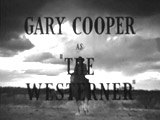

The Westerner (1940), 100 minutes, D: William Wyler
An entertaining western saga, with Walter Brennan (who won a record-setting third Academy Award for his supporting role) and Gary Cooper. The story was told in the era of vicious range wars between cattlemen and homesteaders in the post-Civil War period. Included an impressive Gregg Toland-filmed prairie fire sequence. Drifter cowboy and saddle tramp Cole Hardin (Gary Cooper), on his way through Texas to California, rode into a town (named Langtry) run by notorious, self-appointed, despotic hanging Judge Roy Bean (Walter Brennan), who called himself "the Law west of the Pecos." Hardin was falsely accused of stealing a horse after buying a horse from a horse thief and was taken before the infamous justice of the peace for a mock trial, and sentenced to hang. He talked his way out of being hanged by convincing the judge of his friendship with the judge's obsessive idol, English stage star Lily Langtry (Lilian Bond). Later, he gave the judge a lock of her hair, convincing him it was real. Hardin ended up defending homesteaders on the opposite side from the judge in a bloody and violent range war and land dispute. In the final showdown scene, Hardin confronted the judge in a gas-lit opera theatre in Ft. Davis, Texas with guns drawn before a Langtry performance.